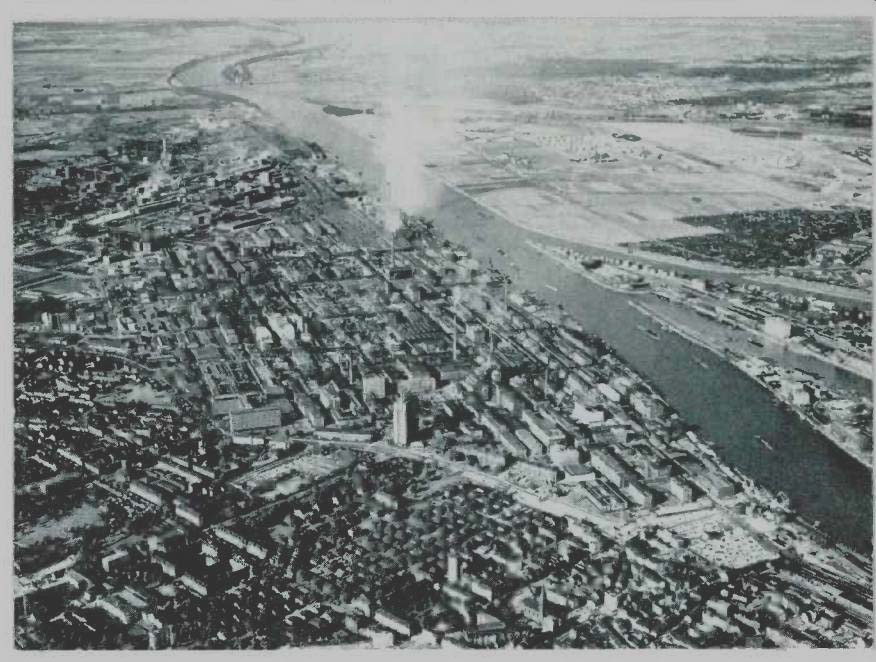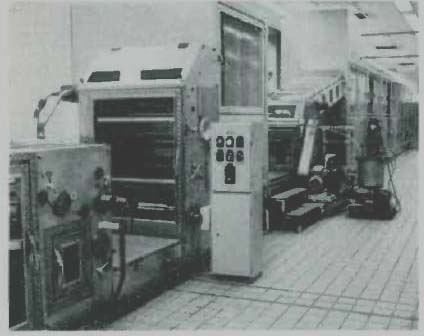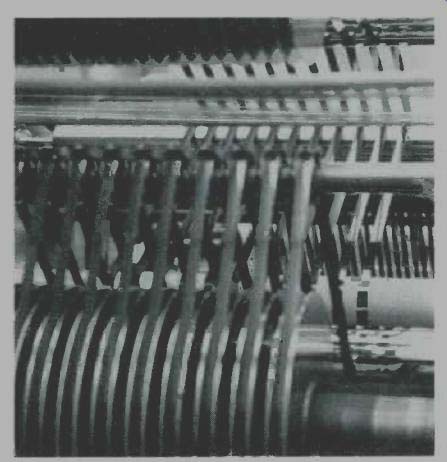by Bert Whyte
AT THE AES convention at the Waldorf-Astoria last fall, I talked with Tom Dempsey, the genial V.P. of BASF Systems. I remarked that though I had been using magnetic tape since 1949, I had never seen it made. Tom promptly invited me to inspect the BASF plant in Bedford, Mass., and to visit BASF headquarters in Ludwigshafen, Germany.

The plant in Bedford is located in a pleasant industrial park, and it is a marvel of clean, functional design, efficiency, and cleanliness. The plant is highly automated, yet hundreds of employees are required in the various departments. This plant manufactures open-reel, cassette, and cartridge tape, and such special items as computer tape and magnetic discs for computers. Not far from the main plant, BASF operates its own plastics factory, which turns out reels of various sizes and shells for cassettes and cartridges, as well as hubs and other cassette parts. Tom Dempsey makes his headquarters in the Bedford plant as does Gerry Berberian, National Sales Mgr., and Heinz Kreuels, Marketing Mgr. Heinz is "Mr. Fixit," generally in charge of "visiting firemen," and making arrangements for overseas visits to BASF. The Bedford plant is similar to the main BASF plant in Germany. However, there are additional facilities in the main plant, so I will describe the tape manufacturing process as conducted in this facility.
On Valentine's Day, my wife Ruth and I deplaned in Frankfurt and were driven to Mannheim, on the West bank of the Rhine, just across from Ludwigshafen. No one would want to stay in Ludwigshafen, as it is literally a "Devil's Cauldron," steam jetting everywhere, multi-hued smoke issuing from myriad stacks, and the most exotic galaxy of noisome stenches I have ever encountered. Needless to say, this has an environmental impact, and BASF spends over $35 million annually in combating pollution.
Badische Anilin and Soda-Fabrik (BASF) is an offshoot and new manifestation of the famous (or infamous) I.G. Farben Industrie chemical and anilin dye cartel, which was disbanded by order of the Allies after the war. BASF is now the third largest chemical company in the world, with annual sales exceeding 3.5 billion dollars.
Allied bombers completely leveled the Ludwigshafen works during the war.
Thus it is hard to believe what you see at present. The term "mind-boggling" is totally inadequate to convey the impression of this industrial colossus. The works stretches along the Rhine for over four miles and extends inland a mile and a half! There are more than 1,500 buildings and the landscape is dotted with chemical processing installations that look like a surrealist's nightmare.
Soaring towers, retorts, condensors, fractionators, all connected by miles of sinuously twisting multi-colored pipes and plumbing. There is a huge railroad complex within the works, as well as docks for the big Rhine barges. Fifty thousand tons of raw material per day are transported within the works. With all the complex processes involved, daily electrical consumption is equivalent to the whole of Denmark! This vast array of plants produces over 5,000 different products.
After we recovered a bit from "jet lag," Mr. Wilhelmus Andriessen, Mgr. of BASF audio products evaluation, drove us to nearby Heidelberg, the famous university town. Mr. Andriessen is very knowledgeable about magnetic tapes and recorders, and a man who knows and loves classical music. He proved an ideal host and after we had visited the great castle we went to one of the typical Heidelberg "Student Prince" drinking stubes, where we supped on Black Forest trout washed down with the fabulous local brews.
The next morning we were off to the rural town of Willstaat, about 75 miles from Mannheim, where the BASF tape manufacturing plant is located. This site was chosen for its relatively clean air, and nearby stream of pure water from the Black Forest (obvious qualities not to be found in Ludwigshafen). Another consideration was the proximity of Strasbourg, France, which furnishes a much-needed labor pool, with workers crossing and re-crossing the border every day, happy to earn the higher German wages.
The tape plant was opened in 1966, and purportedly is the most modern magnetic tape manufacturing facility extant. There are about eight rather stark buildings, which were designed for maximum efficiency in the progression of raw material input, to finished tape output. All the facilities give a rather "clinical" impression, much in keeping with the almost fanatic obsession with the exclusion of dust and dirt from the processing areas.
The BASF tape plant has an important advantage shared by few, if any other tape manufacturers. All the raw materials ... the plastics, the base film, iron oxide, lacquer, and solvents . . . are manufactured by BASF, mostly in the Ludwigshafen plant. They pride themselves on the rigid quality control checks such a situation makes possible.
For example, solvents arriving at the Willstaat plant can be immediately utilized since their purity has been determined beyond question at the main plant.

-------- Coating plant-the dispersion is spread evenly and precisely
onto a wafer-thin plastics carrier film.
For their recording tape BASF manufactures both polyester and "Luvitherm," a PVC film. The BASF tape plant in Bedford uses a lot of Mylar, purchased from DuPont. When the "carrier film" (as the base is called professionally) has been rolled to a uniform thickness, it passes on to a "calendering roller," which gives the film a very smooth surface, increases the suppleness of the tape, and pre-stretches it sufficiently to prevent distortion by the mechanical stresses of running through the tape recorder.
There are, of course, various iron oxide formulations but in general, the material is a gamma ferric oxide, with extremely fine acicular (needle) shaped crystals ... actually they are less than one micron in length and can only be viewed under an electron microscope.
The iron oxide is mixed by the ton in huge ball mills. These are containers filled with thousands of steel balls, which when the oxide is added and rotated continuously for long periods, grind the oxide down to the tiny needle particles. The iron oxide powder is mixed with a lacquer substance and a solvent, which from its highly volatile odor I guessed was acetone or something similar. This combination is now called a dispersion (known as "slurry" in our country) and is mixed very thoroughly to assure uniformity. Now the dispersion is a liquid in which each single iron oxide particle is enveloped in a lacquer coating so that the individual particles . . . no matter how infinitesimal . . . no longer have any direct contact. To guard against any possible agglomerations of particles, the dispersion is put through a special filtration process before being pumped to the coating machines.
The coating machines are in the "white" section, which means all entrance and exit are through air locks. There dust is evacuated by vacuum, and special air conditioning insures constant temperature control. All personnel must wear special dust-free clothing. All these precautions against the intrusion of dust are important for regular types of magnetic tape and even more so for the finicky users of computer tape. The coating machines are of proprietary design and much the same in both the Willstaat and Bedford plants. At the feed end of the coater, the carrier film is washed and dried, and then the liquid dispersion is coated on the base by precision equipment assuring a constant uniform flow. Following the coating station is an inspection device to check the thickness of the coating. In turn, a magnetic field is set up covering the entire width of the film. Since the coating is still moist, the needle particles of oxide are still able to move, and the field orients the particles in the longitudinal plane of the coated film. The freshly coated film passes through a drying tunnel which evaporates the solvent by hot air. The solvent/air mixture is drawn off, liquified, cleaned, and stored for reuse. The now finished magnetic film is checked a second time for uniformity of coating and then wound onto large rolls called "blocks."
Before the wide magnetic film is fed into the precision slitting machines, it passes once again through a "calendering" roller where a combination of heat and pressure improve the surface smoothness and subsequent mechanical "wrap" of the tape. I always had the notion that the slitting machines used razor sharp knives, and that the scalloped edges we used to get now and then were simply a case of a dull knife.
Not so at all. The cutters are spaced sort of wheels, and the edges of the wheels do the trick with a shearing scissor-like type of cutting. There are various slitting machines for different tape widths and by far the most fascinating is that for cassette tape. Before your eyes, this approximately 30-in. wide tape becomes dozens of strands of cassette stock. After slitting into various widths, the tape is sent to the girls in the packing sections, to become open reel, cassettes, and with the special back-lubricated tape . . . cartridges. The special tape for computers is literally inspected inch by inch by a squad of girls, who also test the tapes on standard computer tape drives.

---------High precision cutter unit for computer tapes which cuts the film
into individual tapes with extreme accuracy.
There in essence is how tape is made... certainly a fascinating process, and interesting to watch, but you must be careful you don't get "high" on the solvent fumes!
After being guided through the Willstaat tape manufacturing facility, Hans Cabus, the indefatigable PR man from BASF, took us through the cassette assembly area, where we watched automated machinery putting together upper and lower shells with their tape packs. In this plant the cassettes were assembled with screws. In Bedford the cassette joining is by sonic welding. I don't know why the difference, and I have heard pro and con on the worth of each method. In still another section Mr. Cabus proudly showed us a battery of about 10 Gauss Electro-physics cassette tape duplicators, busily spinning away and producing the world's first Dolbyized chromium dioxide pre-recorded cassettes. Incidentally, BASF makes its own CrO2 tape under du Pont license. Yes, BASF has entered the music business with a bang. In fact, they are even going to make discs as well. The music is both pop and classical, the latter being drawn from the Harmonia Mundi catalog. I have some of the new cassettes and they are really top quality.
After Willstaat, it was over to the immensity of Ludwigshafen, and thence to the lair of Willi Andriessen. In his laboratory, there were scores of cassette machines undergoing tests with BASF tapes. Many "standard" cassette "test beds" did repetitious testing of some aspect of BASF cassettes. The same held true for cartridges, with many units involved in life testing.
Then there were many specialized devices for testing such parameters as tensile strength, stretch resistance, abrasive qualities vs. head wear, and many more.
Our BASF friends did not forget the social amenities and we were regally wined and dined. One night we were the guests of PR chief Mr. Hans Vorier and his charming wife in the little village of Neustadt in the Palatinate wine country which is not too far from Ludwigshafen. We went to this old inn and drank some crisp clean wines and some of the sweeter "spatlese," which don't travel well and we never see in our country.
All in all, we certainly enjoyed our trip and learned a great deal about magnetic tape. Our German friends at BASF made every effort to assure us a good time. They are gracious and discerning hosts.
So it was that Ruth and I boarded the wonderful "Rembrandt" train to go up the west bank of the Rhine through the wine country to Amsterdam and thence to Rotterdam for the European convention of the AES. Mention of current happenings concerning the CD-4 discrete system were inadvertently omitted from this column in May. We complete that article now to keep you up to date.
Warner/Elektra/Atlantic record group announced they would adopt the CD-4 system for their quadraphonic recordings. Thus the discrete disc camp gets a tremendous boost, since the WEA group is one of the dominant companies in the pop field. Between RCA and WEA, the CD-4 system can now claim to be used by one third of the industry.
JVC also claims that since the WEA announcement, licensing negotiations are now proceeding with other record companies, including a prominent and prestigious European company.
JVC further announced that virtually all hardware manufacturers in Japan with the exception of Sony, have signed licensing agreements to use CD-4 in their equipment. Also, because of the WEA agreement, JVC is setting up a cutting system in Los Angeles, which they claim can cut 200 CD-4 masters per month. This cutting channel will be a half-speed (1635) unit. Speaking of which, I recently visited Bill Dearborn, chief engineer of RCA Records, and he showed me his CD-4 cutting channel.
His unit still operates at 11.33 rpm, which was the original CD-4 speed, and which had certain limitations. Bill expects to go to half-speed operation shortly, and points out that the Neumann lathe has provision for a standard plug-in 1635 rpm speed change module, and that the Dolby A units have long had 1635 cards available. Bill is also using a new cutting stylus with a back angle of 35 degrees instead of 45 degrees. (Incidentally, the cutter is now helium cooled.) This change in back angle enables cutting further into the inner diameters of the lacquers with good resolution; thus the time factor on a CD-4 disc, a somewhat controversial point, is extended and Bill claims that 28-29 minutes per side, even with relatively high velocity material, is possible. Another advantage of the 1635 speed is that the lowest frequency involved is 15 Hz, rather than the 11 Hz of the 11.33 rpm operation. In practical terms, this means better bass response on playback.
RCA has finally begun to release more CD-4 discs. I have an excellent new Mancini recording of some Sousa marches . . . plenty of rousing brass and good bass drums. Best of all, is a fine classical output, mainly Philadelphia Orchestra recordings of such as the Sibelius 2nd Sym., Scheherazade, La Mer, Rachmaninoff 2nd Piano Conc. with Rubenstein, some Bach Double Fugue orchestral transcriptions.
JVC has now over 200 CD-4 discs in Japan, and while none of these were allowed to be imported into the U.S. up to now, a new agreement with RCA allows some to reach our shores ... . providing there is no conflict in terms of repertoire. So the software picture which has been a weak point of the Quadradisc program is being improved, and of course, with the anticipated WEA releases, the output will increase rapidly.
Does all this CD-4 activity mean that the matrix people ... the QS and SQ proponents, are losing ground? A hard question to answer, but I still feel that we are to have co-existence of these systems for quite a while yet. SQ still has a formidable amount of software on the market, and plenty of equipment is equipped to decode the discs.
QS has an excellent variable matrix decoder that is now beginning to appear on some new Sansui receivers. Recently Ben Bauer, the genial "quadfather" of the CBS SQ system, let me hear his new "Parametric" matrix decoder, and it certainly provided an impressive four-channel sound. It would be silly to deny that all the CD-4 activity in recent weeks, hasn't had a big impact with many record companies. Some say it is the beginning of a trend. I personally think it will be interesting to see what happens when in the next month or so, the SQ logic IC chip and the Panasonic demodulator chip arrive on the market almost simultaneously!
(Audio magazine, Jul. 1973; Bert Whyte)
= = = =